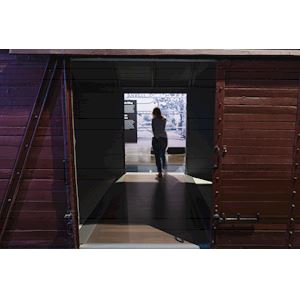
111 - Bearing Witness - Camps and Killing Sites
NARRATOR As they learn more about the Holocaust and gain more insight into how genocide works, historians have adjusted their language to reflect the reality of what happened. For example, in the past, “extermination” was a term used to describe killing in the Holocaust. However, in the English language, the word “extermination” has a specific use because it describes killing vermin—rats; insects; swarming, filthy creatures. Not humans. These same images—vermin—were used in propaganda by the Nazis to set the Jews apart—to isolate and negate them as people. During the Holocaust, Jews were not exterminated. They were not vermin. They were people who were murdered by other people. All camps were death camps because death occurred at all of them. If the victims survived or thrived, the system had failed. A concentration camp was a facility that confined a concentration of people. Some concentration camps were slave labor camps that fed local industries with expendable workers. They were worked to death. Walter Kase: "We worked in this camp, we worked with Poles who came there to work. We came as slave workers. We were not paid for it." NARRATOR Allen Wayne: "They took a lot of people to work into the firearm factory. They took me. They put me up on the pistol factory, pistol machines…I worked three machines, there was no way I could do a good job and I was breaking a lot of tools…so I was warned…I was told if it's going to happen again I'm going to be shot…" NARRATOR Some camps, however, had a specific and specialized purpose: murder. Six killing centers were designed to murder the innocent, efficiently and resourcefully. They were factories of death—the engines of the Final Solution. Auschwitz-Birkenau was the largest and deadliest killing center, murdering 1.1 million people. Chelmno was the site of nearly a quarter-million murders by carbon monoxide asphyxiation. At Belzec, approximately a half-million people were murdered in ten months. Sobibor executed up to 200,000 Jews in its gas chambers. Treblinka could murder eight to ten thousand people a day in its gas chamber, totaling 925,000 killings. Majdanek provided both forced labor and murder. 40,000 Jews died in its gas chambers. 18,000 more were killed in a mass shooting spree called “Harvest Festival.”


Holocaust Museum Houston
Holocaust Museum Houston is dedicated to educating people about the Holocaust, remembering the 6 million Jews and other innocent victims and honoring the survivors’ legacy. Using the lessons of the Holocaust and other genocides, we teach the dangers of hatred, prejudice, and apathy.
- 5401 Caroline
- Houston United States
- 713-942-8000
- www.hmh.org
